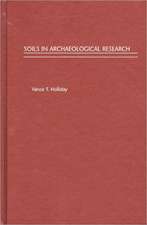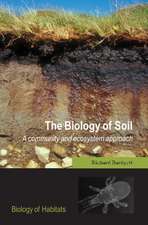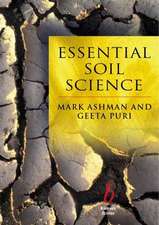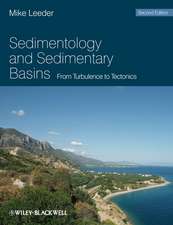Carbon Sequestration in Agricultural Soils: A Multidisciplinary Approach to Innovative Methods
Editat de Alessandro Piccoloen Limba Engleză Paperback – 22 feb 2014
| Toate formatele și edițiile | Preț | Express |
|---|---|---|
| Paperback (1) | 641.85 lei 6-8 săpt. | |
| Springer Berlin, Heidelberg – 22 feb 2014 | 641.85 lei 6-8 săpt. | |
| Hardback (1) | 646.62 lei 6-8 săpt. | |
| Springer Berlin, Heidelberg – 13 ian 2012 | 646.62 lei 6-8 săpt. |
Preț: 641.85 lei
Preț vechi: 755.13 lei
-15% Nou
Puncte Express: 963
Preț estimativ în valută:
122.81€ • 128.24$ • 101.42£
122.81€ • 128.24$ • 101.42£
Carte tipărită la comandă
Livrare economică 15-29 aprilie
Preluare comenzi: 021 569.72.76
Specificații
ISBN-13: 9783642429262
ISBN-10: 3642429262
Pagini: 324
Ilustrații: XIV, 310 p.
Dimensiuni: 155 x 235 x 17 mm
Greutate: 0.46 kg
Ediția:2012
Editura: Springer Berlin, Heidelberg
Colecția Springer
Locul publicării:Berlin, Heidelberg, Germany
ISBN-10: 3642429262
Pagini: 324
Ilustrații: XIV, 310 p.
Dimensiuni: 155 x 235 x 17 mm
Greutate: 0.46 kg
Ediția:2012
Editura: Springer Berlin, Heidelberg
Colecția Springer
Locul publicării:Berlin, Heidelberg, Germany
Public țintă
ResearchCuprins
The nature of Soil Organic Matter and innovative soil managements to fight global changes and maintain agricultural productivity.- The Kyoto protocol and European and Italian regulations in Agriculture.-
Field plots and crop yields under innovative methods of carbon sequestration in soil.- Carbon sequestration in soils by hydrophobic protection and in-situ catalyzed photo-polymerization of soil organic matter (SOM). Chemical and physical-chemical aspects of SOM in field plots.- The stable isotopes approach to study C and N sequestration processes in a plant–soil system.- Impact of innovative agricultural practices of carbon sequestration on soil microbial community.- Effects of methods of carbon sequestration in soil on biochemical indicators of soil quality.- Biological and biotechnological evaluation of Carbon dynamics in field experiments.- Measurements of CO2 and N2O emissions in the agricultural field experiments of the ESCOSAGR project.- Effects of carbon sequestration methods on soil respiration and root systems in microcosm experiments and in vitro studies.- New modelling approach to describe and predict carbon sequestration dynamics in agricultural soils.
Field plots and crop yields under innovative methods of carbon sequestration in soil.- Carbon sequestration in soils by hydrophobic protection and in-situ catalyzed photo-polymerization of soil organic matter (SOM). Chemical and physical-chemical aspects of SOM in field plots.- The stable isotopes approach to study C and N sequestration processes in a plant–soil system.- Impact of innovative agricultural practices of carbon sequestration on soil microbial community.- Effects of methods of carbon sequestration in soil on biochemical indicators of soil quality.- Biological and biotechnological evaluation of Carbon dynamics in field experiments.- Measurements of CO2 and N2O emissions in the agricultural field experiments of the ESCOSAGR project.- Effects of carbon sequestration methods on soil respiration and root systems in microcosm experiments and in vitro studies.- New modelling approach to describe and predict carbon sequestration dynamics in agricultural soils.
Field plots and crop yields under innovative methods of carbon sequestration in soil.- Carbon sequestration in soils by hydrophobic protection and in-situ catalyzed photo-polymerization of soil organic matter (SOM). Chemical and physical-chemical aspects of SOM in field plots.- The stable isotopes approach to study C and N sequestration processes in a plant–soil system.- Impact of innovative agricultural practices of carbon sequestration on soil microbial community.- Effects of methods of carbon sequestration in soil on biochemical indicators of soil quality.- Biological and biotechnological evaluation of Carbon dynamics in field experiments.- Measurements of CO2 and N2O emissions in the agricultural field experiments of the ESCOSAGR project.- Effects of carbon sequestration methods on soil respiration and root systems in microcosm experiments and in vitro studies.- New modelling approach to describe and predict carbon sequestration dynamics in agricultural soils.
Field plots and crop yields under innovative methods of carbon sequestration in soil.- Carbon sequestration in soils by hydrophobic protection and in-situ catalyzed photo-polymerization of soil organic matter (SOM). Chemical and physical-chemical aspects of SOM in field plots.- The stable isotopes approach to study C and N sequestration processes in a plant–soil system.- Impact of innovative agricultural practices of carbon sequestration on soil microbial community.- Effects of methods of carbon sequestration in soil on biochemical indicators of soil quality.- Biological and biotechnological evaluation of Carbon dynamics in field experiments.- Measurements of CO2 and N2O emissions in the agricultural field experiments of the ESCOSAGR project.- Effects of carbon sequestration methods on soil respiration and root systems in microcosm experiments and in vitro studies.- New modelling approach to describe and predict carbon sequestration dynamics in agricultural soils.
Field plots and crop yields under innovative methods of carbon sequestration in soil.- Carbon sequestration in soils by hydrophobic protection and in-situ catalyzed photo-polymerization of soil organic matter (SOM). Chemical and physical-chemical aspects of SOM in field plots.- The stable isotopes approach to study C and N sequestration processes in a plant–soil system.- Impact of innovative agricultural practices of carbon sequestration on soil microbial community.- Effects of methods of carbon sequestration in soil on biochemical indicators of soil quality.- Biological and biotechnological evaluation of Carbon dynamics in field experiments.- Measurements of CO2 and N2O emissions in the agricultural field experiments of the ESCOSAGR project.- Effects of carbon sequestration methods on soil respiration and root systems in microcosm experiments and in vitro studies.- New modelling approach to describe and predict carbon sequestration dynamics in agricultural soils.
Field plots and crop yields under innovative methods of carbon sequestration in soil.- Carbon sequestration in soils by hydrophobic protection and in-situ catalyzed photo-polymerization of soil organic matter (SOM). Chemical and physical-chemical aspects of SOM in field plots.- The stable isotopes approach to study C and N sequestration processes in a plant–soil system.- Impact of innovative agricultural practices of carbon sequestration on soil microbial community.- Effects of methods of carbon sequestration in soil on biochemical indicators of soil quality.- Biological and biotechnological evaluation of Carbon dynamics in field experiments.- Measurements of CO2 and N2O emissions in the agricultural field experiments of the ESCOSAGR project.- Effects of carbon sequestration methods on soil respiration and root systems in microcosm experiments and in vitro studies.- New modelling approach to describe and predict carbon sequestration dynamics in agricultural soils.
Textul de pe ultima copertă
This compilation of techniques, methodologies and scientific data arises from a four-year Italian research project, which took place at university research stations in Turin, Piacenza, Naples and Potenza. Soil Organic Matter (SOM) represents an active and essential pool of the total organic carbon on the planet. Consequently, even small changes in this SOM carbon pool may have a significant impact on the concentration of atmospheric CO2. Recent new understanding of the chemical nature of SOM indicates that innovative and sustainable technologies may be applied to sequester carbon in agricultural soils. Overall results of the project have been applied to develop an innovative model for the prediction and description, both quantitatively and qualitatively, of carbon sequestration in agricultural soils. This book provides experts in different areas of soil science with a complete picture of the effects of new soil management methods and their potentials for practicalapplication in farm management.
Caracteristici
An exploration of an area hardly pursued because of limited understanding of the cycle of organic carbon in soils A report of the techniques and methodologies used by the research groups during the four-year national Italian project (FISR-MESCOSAGR) The results have been applied to develop an innovative model to predict and describe, both quantitatively and qualitatively, sequestered organic carbon compounds in the treated soils Includes supplementary material: sn.pub/extras











